 Near AIIMS Phulwari Sharif Patna
Near AIIMS Phulwari Sharif Patna [email protected]
[email protected] 7369848448
7369848448
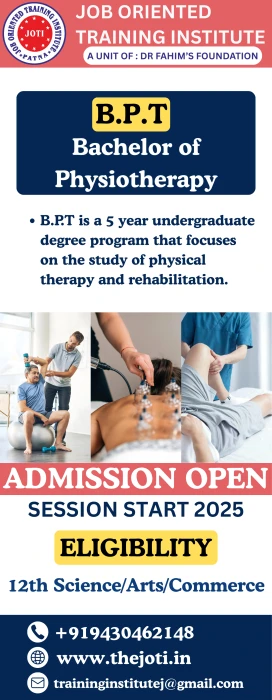
Here is a syllabus for a 4-year Bachelor of Physiotherapy (BPT) program: Year 1: - Semester 1: - Anatomy - Physiology - Biomechanics - Kinesiology - Introduction to Physiotherapy - Semester 2: - Physiotherapy Techniques - Therapeutic Exercises - Electrotherapy - Heat and Cold Therapy - Massage and Manual Therapy Year 2: - Semester 3: - Musculoskeletal Physiotherapy - Neurological Physiotherapy - Cardiovascular and Respiratory Physiotherapy - Pediatric Physiotherapy - Geriatric Physiotherapy - Semester 4: - Research Methods and Biostatistics - Physiotherapy in Sports - Occupational Health and Ergonomics - Community-Based Rehabilitation - Pharmacology and Pharmacotherapy Year 3: - Semester 5: - Advanced Musculoskeletal Physiotherapy - Advanced Neurological Physiotherapy - Advanced Cardiovascular and Respiratory Physiotherapy - Advanced Pediatric Physiotherapy - Advanced Geriatric Physiotherapy - Semester 6: - Clinical Reasoning and Decision Making - Leadership and Management in Physiotherapy - Health Promotion and Education - Interprofessional Collaboration and Communication - Electives (e.g., Manual Therapy, Acupuncture, etc.) Year 4: - Semester 7: - Internship/ Clinical Placement - Research Project/ Dissertation - Advanced Research Methods and Biostatistics - Specialized Physiotherapy Courses (e.g., Orthopedic Manual Therapy, Neurological Rehabilitation, etc.) - Professional Development and Entrepreneurship
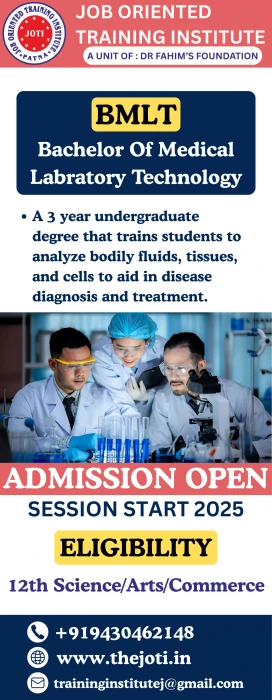
Here is a general syllabus for a 3-year Bachelor of Medical Laboratory Technology (BMLT) program: Year 1: - Semester 1: - Introduction to Medical Laboratory Technology - Anatomy and Physiology - Biochemistry - Microbiology - Laboratory Safety and Ethics - Semester 2: - Clinical Biochemistry - Hematology - Immunology - Molecular Biology - Laboratory Instrumentation Year 2: - Semester 3: - Clinical Microbiology - Parasitology - Serology - Blood Banking - Urinalysis - Semester 4: - Histopathology - Cytology - Immunohematology - Molecular Diagnostics - Research Methodology Year 3: - Semester 5: - Advanced Clinical Biochemistry - Advanced Hematology - Advanced Microbiology - Quality Control and Quality Assurance - Laboratory Management - Semester 6: - Project Work/Dissertation - Viva Voce Electives (choose one): - Medical Imaging Technology - Medical Informatics - Healthcare Management - Epidemiology Practical Training: - Students will undergo practical training in various laboratory settings, including clinical biochemistry, hematology, microbiology, and molecular diagnostics. Internship: - Students will undergo a 6-month internship in a hospital or laboratory setting, where they will gain hands-on experience in medical laboratory technology. Note: The syllabus may vary depending on the institution and country. This is just a general outline.
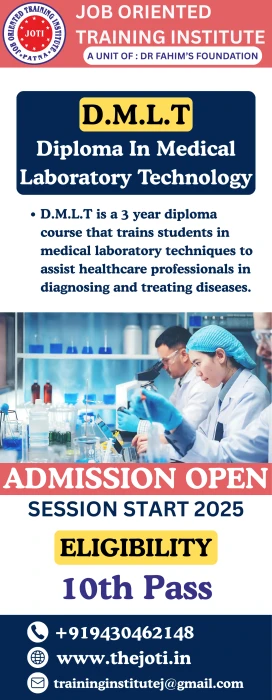
Here is a syllabus for a 3-year DMLT (Diploma in Medical Laboratory Technology) program: Year 1: - Semester 1: - Anatomy and Physiology - Biochemistry - Introduction to Medical Laboratory Technology - Laboratory Safety and Management - Semester 2: - Pathology - Microbiology - Hematology - Blood Banking and Transfusion Medicine Year 2: - Semester 3: - Clinical Biochemistry - Medical Microbiology - Immunology - Serology - Semester 4: - Parasitology - Histopathology and Cytology - Laboratory Instrumentation and Maintenance - Quality Control and Quality Assurance Year 3: - Semester 5: - Molecular Diagnostics - Cytogenetics - Immunohematology - Laboratory Management and Administration - Semester 6: - Research Methodology and Biostatistics - Advanced Medical Laboratory Techniques - Clinical Correlation and Case Studies - Project Work/Dissertation Note: The syllabus may vary depending on the institution and the specific program. This is just a general outline. Additionally, there may be practical exams, viva voce, and project work throughout the program.
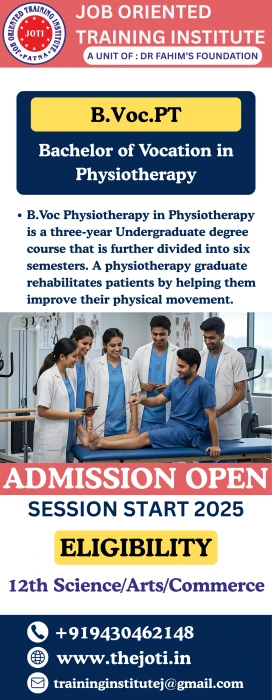
A B.Voc in Physiotherapy is a three-year undergraduate vocational degree designed to train students as physiotherapy assistants and technologists by providing practical skills and theoretical knowledge in physical rehabilitation, exercise therapy, and patient care. The program offers hands-on experience in assessing and treating musculoskeletal and neurological conditions, with a focus on clinical practice and working in various healthcare settings under the supervision of professional physiotherapists. Key aspects of the B.Voc in Physiotherapy: Career-focused: The program is centered on preparing students for skilled roles in the healthcare industry, rather than becoming a fully licensed physiotherapist. Practical Skills: Students gain hands-on experience with patient care, therapeutic exercises, manual therapy techniques, and the use of modern equipment. Curriculum: The coursework includes subjects like anatomy, physiology, pathology, rehabilitation strategies, and professional ethics. Role of a Graduate: Graduates are prepared to assist physiotherapists in providing treatments and rehabilitation services to patients in hospitals, rehabilitation centers, and other healthcare environments. Integration of Theory and Practice: The B.Voc program combines theoretical knowledge with significant practical training and clinical exposure to prepare students for the demands of the healthcare environment. What to expect from a B.Voc in Physiotherapy: Assessment and Treatment: You'll learn to assess and treat physical impairments and disabilities, focusing on enhancing patient mobility and recovery. Patient-Centered Care: The course emphasizes the importance of patient care, communication skills, and ethical practice. Diverse Settings: Graduates can find opportunities to work in various healthcare settings, including hospitals, private practices, and rehabilitation centers. Industry Relevance: The vocational nature of the degree ensures that graduates are equipped with the specific skills and knowledge required for the job market in physiotherapy.
This course will develop your potential and confidence.
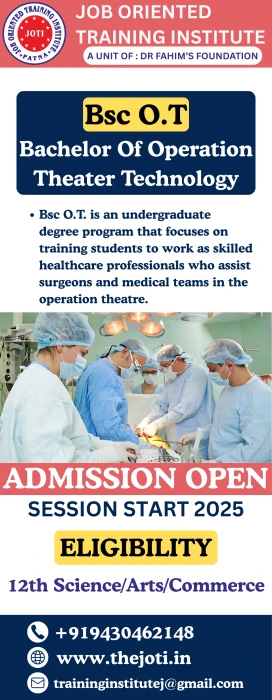
Here is a syllabus for a 3-year Bachelor's program in Operation Theatre Technology (OTT): Year 1: - Semester 1: - Introduction to Operation Theatre Technology - Anatomy and Physiology - Surgical Procedures and Techniques - Operation Theatre Equipment and Instruments - Sterilization and Disinfection - Semester 2: - Patient Safety and Care - Surgical Nursing and Assistance - OT Management and Organization - Medical Ethics and Law - Communication and Interpersonal Skills Year 2: - Semester 3: - Advanced Surgical Procedures and Techniques - Anesthesia and Anesthetic Techniques - OT Technology and Innovations - Quality Control and Quality Assurance - Research Methods and Statistics - Semester 4: - Clinical Workshops and Seminars - Case Studies and Discussions - Internship in OT Department - Advanced OT Equipment and Instrumentation - Specialized Surgical Procedures Year 3: - Semester 5: - Advanced OT Management and Organization - Leadership and Team Management - Patient Education and Counseling - Healthcare Policy and Administration - Advanced Research Methods and Statistics - Semester 6: - Project Work/Dissertation - Advanced Clinical Workshops and Seminars - Continuing Education and Professional Development - Review and Preparation for Certification Exams Note: This syllabus may vary depending on the institution and program. Some programs may also include additional topics or specializations. This syllabus provides a comprehensive education and training in operation theatre technology, preparing students for roles such as OT managers, surgical assistants, and anesthetic technicians.
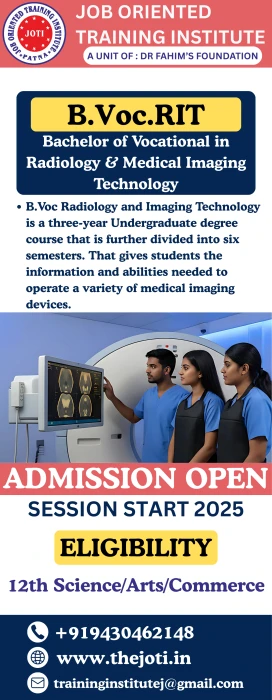
A Bachelor of Vocation (B.Voc) in Radiology and Imaging Technology is a three-year undergraduate program focusing on vocational training in diagnostic imaging procedures. The curriculum is highly industry-oriented, designed to equip students with practical skills and hands-on experience using modern medical imaging equipment. Course overview This skill-based degree trains students to become radiology technologists who can operate sophisticated diagnostic imaging equipment like X-ray, CT scans, and MRI machines. It is different from a traditional B.Sc. in Radiology, as the B.Voc provides more practical training for immediate employability. Duration The course lasts for three years, divided into six semesters. Many programs also include a mandatory internship in a hospital or diagnostic center. Key subjects Core subjects typically covered in the syllabus include: Human Anatomy and Physiology Radiation Physics and Safety Radiographic and Image Processing Techniques Specific imaging modalities like CT, MRI, and ultrasound Patient Care and Medical Ethics Eligibility criteria To be eligible for the program, candidates must have completed their 10+2 (or equivalent) education, usually in the science stream. Requirements may include: A science background with subjects like Physics, Chemistry, and Biology. A minimum aggregate score of around 50% in the 12th board examination. Some colleges may require a specific entrance examination for admission. Career opportunities After completing a B.Voc in Radiology and Imaging Technology, graduates can find various roles in hospitals, diagnostic centers, clinics, and medical imaging companies. Potential career paths include: Radiology Technologist/Radiographer: Performs general diagnostic imaging procedures, such as X-rays. CT Scan Technologist: Specializes in operating Computed Tomography (CT) scanners. MRI Technologist: Operates Magnetic Resonance Imaging (MRI) machines to produce detailed images of the body. Ultrasound Technologist (Sonographer): Uses high-frequency sound waves to create images of internal body structures. Nuclear Medicine Technologist: Prepares and administers radioactive drugs for imaging and treatment. Application Specialist: Works with companies that manufacture medical imaging equipment to provide technical support and sales assistance. Radiology Supervisor or Manager: Oversees the daily operations of an imaging department after gaining experience.
An electrocardiogram (ECG or EKG) is a quick, non-invasive, and painless test that records the heart's electrical activity. Each time the heart beats, an electrical signal travels through it, causing the heart's chambers to contract and pump blood. An ECG measures these electrical impulses to evaluate the heart's rate, rhythm, and overall health. How an ECG works During an ECG, small, sticky sensors called electrodes are placed on your chest, arms, and legs. Detection of signals: The electrodes detect the electrical signals produced by your heart as it beats. Transmission: Wires, or "leads," connect the electrodes to an ECG machine. Recording: The machine converts the signals into a wave pattern and records them on a screen or paper. Analysis: A healthcare provider interprets this graph to look for patterns that might indicate a problem. What an ECG can show Healthcare providers use ECG results to diagnose and monitor a variety of heart conditions: Heart rate and rhythm: An ECG can help diagnose an unusually fast heart rate (tachycardia) or a slow heart rate (bradycardia), as well as irregular heartbeats (arrhythmias) like atrial fibrillation. Heart attack: The test can reveal signs of a past or current heart attack by showing which part of the heart muscle may be damaged. Blood supply: An ECG can show if the heart muscle is getting an adequate supply of blood and oxygen. Heart structure: The results can provide clues about heart structure changes, such as an enlarged heart or congenital defects. Treatment effectiveness: The test can also check how well treatments for heart disease, like a pacemaker, are working. Types of ECGs The type of ECG performed depends on the patient's symptoms and what the doctor needs to evaluate. Standard 12-lead ECG: This resting ECG is performed while the patient lies still. It provides a brief "snapshot" of the heart's activity and is often the first test for signs of a heart condition. Stress or exercise ECG: This test records the heart's electrical activity while the patient is exercising on a treadmill or stationary bike. It helps doctors see how the heart performs under stress. Holter monitor: This portable ECG device is worn for one to two days to record the heart's activity during daily activities. It is useful for capturing intermittent symptoms that a standard ECG might miss. Event monitor: Similar to a Holter monitor, this device is worn for a longer period (up to 30 days) and records the heart's rhythm only when the patient activates it or when it detects an irregular heart rhythm. When is an ECG performed? Your doctor may recommend an ECG if you experience symptoms like: Chest pain Dizziness, lightheadedness, or fatigue Shortness of breath A pounding, fluttering, or skipping heartbeat (palpitations) It can also be performed as part of a routine checkup or to monitor heart health if you have risk factors for heart disease, like a family history of heart problems.
A medical dresser course is a type of paramedical program that trains individuals in basic patient care, wound dressing, and first aid. Graduates can work in hospitals, clinics, and other healthcare settings assisting doctors and nurses. Course types and duration The program is offered at both the certificate and diploma levels. Certificate in Medical Dresser (CMD): This is typically a shorter, one-year course with eligibility starting from Class 10 or 12, depending on the institute. Diploma in Medical Dresser: Some institutes offer a diploma, which is also generally a one-year course, though eligibility may require completion of the 12th standard, often with a science background. Curriculum The curriculum focuses on practical skills and foundational medical knowledge, including: Basic human anatomy and physiology Types of wounds and injuries First aid and emergency care Wound dressing and bandaging techniques Infection control and sterilization methods Handling medical instruments and chemical solutions Patient handling and basic communication Eligibility and admission Eligibility: The minimum educational requirement can range from a 10th-grade pass for certificate programs to a 12th-grade pass, often in the science stream, for diploma courses. Admission: Most admissions are based on a merit list derived from your qualifying exams. Some institutes may also conduct an interview. Career scope After completing a dresser course, you can find employment in various healthcare settings: Hospitals and clinics: As a medical dresser, you assist with wound care and basic patient support. Primary healthcare centers: You can provide first aid and wound care in rural or community health settings. Emergency care units: Trained dressers can assist with initial wound management and patient stabilization. Nursing homes and rehabilitation centers: You can provide wound care for long-term patients. Industrial and school facilities: Graduates can work as first-aid assistants. Home care settings: Opportunities are available to provide wound care and assistance to patients in their homes.
Cupping Therapy (CT) is an ancient method and currently used in the treatment of a broad range of medical conditions. Nonetheless the mechanism of action of (CT) is not fully understood. This review aimed to identify possible mechanisms of action of (CT) from modern medicine perspective and offer possible explanations of its effects. English literature in PubMed, Cochrane Library and Google Scholar was searched using key words. Only 223 articles identified, 149 records screened, and 74 articles excluded for irrelevancy. Only 75 full-text articles were assessed for eligibility, included studies in this review were 64. Six theories have been suggested to explain the effects produced by cupping therapy. Pain reduction and changes in biomechanical properties of the skin could be explained by “Pain-Gate Theory”, “Diffuse Noxious Inhibitory Controls” and “Reflex zone theory”. Muscle relaxation, changes in local tissue structures and increase in blood circulation might be explained by “Nitric Oxide theory”. Immunological effects and hormonal adjustments might be attributed to “Activation of immune system theory”. Releasing of toxins and removal of wastes and heavy metals might be explained by “Blood Detoxification Theory”. These theories may overlap or work interchangeably to produce various therapeutic effects in specific ailments and diseases.
Anatomy
Physiology
Yin and Yang
Cupping Technique
Case Studies
Course Outline: 1. Introduction to Goniometry in Physiotherapy - Importance of angle measurements in physiotherapy - Types of goniometers and their uses 2. Understanding Range of Motion - Definition and significance of range of motion - Normal values for joint range of motion 3. Goniometric Assessment Techniques - Measuring joint angles with a goniometer - Assessment of flexion, extension, abduction, adduction, rotation, and circumduction 4. Documenting Goniometric Measurements - Recording range of motion measurements - Interpreting and reporting goniometric data 5. Clinical Applications of Goniometry - Assessment and treatment of joint mobility and stiffness - Injury rehabilitation and prevention 6. Advanced Goniometry Topics - Three-dimensional motion analysis - Goniometry in special populations (e.g., pediatrics, geriatrics) 7. Case Studies and Practical Applications - Real-world examples and problems - Group discussions and hands-on practice Assessment: - Quizzes and assignments (40%) - Practical exam (30%) - Case study presentation (30%) Textbook: - "Goniometry in Physiotherapy" by [Author's Name] Prerequisites: - Basic knowledge of anatomy and physiology - Physiotherapy fundamentals Target Audience: - Physiotherapy students - Practicing physiotherapists - Other healthcare professionals (e.g., occupational therapists, athletic trainers) interested in goniometry and range of motion assessment.